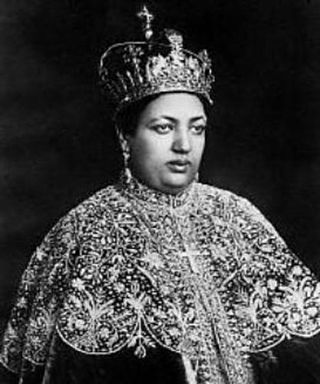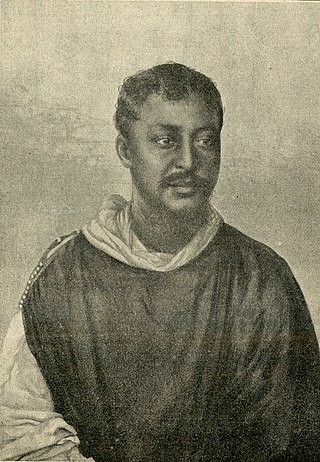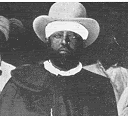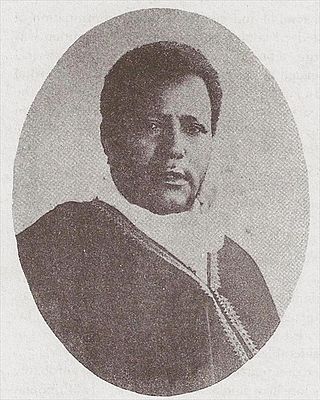Related Research Articles

Menelik II, baptised as Sahle Maryam was king of Shewa from 1866 to 1889 and Emperor of Ethiopia from 1889 to his death in 1913. At the height of his internal power and external prestige, the process of territorial expansion and creation of the modern empire-state was completed by 1898.

Lij Iyasu was the designated Emperor of Ethiopia from 1913 to 1916. His baptismal name was Kifle Yaqob. Ethiopian emperors traditionally chose their regnal name on the day they were crowned, and since he was never crowned, he is usually referred to as Lij Iyasu, "Lij" meaning child, especially one born of royal blood.

Zewditu was Empress of Ethiopia from 1916 until her death in 1930. The first female head of an internationally recognized country in Africa in the 19th and 20th centuries, and the first and only empress regnant of the Ethiopian Empire, her reign was noted for the reforms of her Regent and designated heir Ras Tafari Makonnen, about which she was at best ambivalent and often stridently opposed, due to her staunch conservatism and strong religious devotion. She is the most recent empress regnant, as well as the last female Ethiopian head of state until the 2018 election of Sahle-Work Zewde as president.

Menen Asfaw was Empress of Ethiopia as the wife of Emperor Haile Selassie.
Ankober, formerly known as Ankobar, is a town in central Ethiopia. Located in the North Shewa Zone of the Amhara Region, it's perched on the eastern escarpment of the Ethiopian Highlands at an elevation of about 2,465 meters (8,100 ft). It is 40 kilometers (25 mi) to the east of Debre Birhan and about 90 miles (140 km) northeast of Addis Ababa.

Until the end of the Ethiopian monarchy in 1974, there were two categories of nobility in Ethiopia and Eritrea. The Mesafint, the hereditary royal nobility, formed the upper echelon of the ruling class. The Mekwanint were the appointed nobles, often of humble birth, who formed the bulk of the aristocracy. Until the 20th century, the most powerful people at court were generally members of the Mekwanint appointed by the monarch, while regionally, the Mesafint enjoyed greater influence and power. Emperor Haile Selassie greatly curtailed the power of the Mesafint to the benefit of the Mekwanint, who by then were essentially coterminous with the Ethiopian government.

The Battle of Segale was a civil conflict in the Ethiopian Empire between the supporters of Empress regent Zewditu and Lij Iyasu on 27 October 1916, and resulted in victory for Zewditu. Paul B. Henze states that "Segale was Ethiopia's greatest battle since Adwa" (1896).

RasMengesha Yohannes was governor of Tigray and a son of Emperor Yohannes IV. His mother was Welette Tekle Haymanot wife of dejazmach Gugsa Mercha. Ras Araya Selassie Yohannes was his younger half brother. Prior to the Battle of Metemma, Mengesha Yohannes was considered to be a nephew of Emperor Yohannes IV. During the battle, the Emperor was mortally wounded and it was on his deathbed that Mengesha Yohannes was acknowledged as his "natural" son and designated as his heir. This created something of a succession problem.

RasDesta Damtew KBE was an Ethiopian noble, an army commander, and a son-in-law of Emperor Haile Selassie I. He is known for his leadership in the Ethiopian Army during the Second Italo-Ethiopian War. He was executed on 24 February 1937, by the Italian Armed Forces shortly after Ethiopia's loss in the war.

Prince (Abeto Lij)Girma Yohannes Iyasu is the Iyasuist claimant to the throne of Ethiopian Empire. He is also known by the name Girma Amente Ghebresillasie.

RasMulugeta Yeggazu was an Ethiopian government official, who served in the first cabinet formed by Emperor Menelik II. He served as Imperial Fitawrari, Commander of the Mahel Sefari of the Ethiopian Army during the Second Italo-Ethiopian War.

Gugsa Welle, also known as Gugsa Wale, Gugsa Wolie and Gugsa Wele, was an army commander and a member of the imperial family of the Ethiopian Empire. He represented a provincial ruling elite which was often at odds with the Ethiopian central government.

Seyoum Mengesha KBE was an army commander and a member of the royal family of the Ethiopian Empire.

NegusMikael of Wollo, was an army commander and a member of the nobility of the Ethiopian Empire. He was the father of the "uncrowned" Emperor Lij Iyasu, and the grandfather of Empress Menen, wife of Emperor Haile Selassie. He changed his name to Mikael upon converting to Christianity.
Hailu Tekle Haymanot, also named Hailu II of Gojjam, was an army commander and a member of the nobility of the Ethiopian Empire. He represented a provincial ruling elite who were often at odds with the Ethiopian central government. Hailu Tekle Haymanot was an independent-minded potentate who, throughout his life, was mistrustful of and mistrusted by the Emperor.
Gugsa Wale's rebellion of 1930 was a rebellion raised by Ras Gugsa Wale and by supporters of Empress Zewditu to rid her of the Crown Prince and heir apparent, Negus Tafari Makonnen. With Tafari gone, Zewditu would be the sole claimant to succession as the ruler of the Ethiopian Empire. As the husband of Empress Zewditu, Gugsa Wale expected to become Emperor.

FitawrariHabte Giyorgis Dinagde also known by his horse name Abba Mechal was an Ethiopian military commander and government official who, among several other posts, served as President of the Council of Ministers and as Minister of War during the reigns of Menelik II, Zewditu and Haile Selassie. He was also Shum or Governor of Borena, Ibat, and Mecha.

LijSeifu Mikael was an Ethiopian noble, member of the Solomonic dynasty, belonging to the aristocratic Amhara family from Ankober Shewa. He was the grandson of Dejazmatch Mekuria Tesfaye of Menz, a prominent general, a cousin of Emperor Menelik II of Ethiopia, and grandson of King Sahle Selassie of Shewa. Lij Seifu, a public figure, was educated in Paris at the Sorbonne. He was one of the first few earlier members of the royalty who started paying salaries to their household servants advocating freedom of slaves and an avid supporter of Ras Tafari in his bid to become an emperor of Ethiopia. He served as Ethiopia's minister to France and Germany while he lived in Europe in the 1910s, Ethiopia's Consul General to Eritrea from 1921 to 1925 and Governor of several districts till the eve of the fascist invasion of Ethiopia.

Welde Giyorgis Aboye was one of the most prominent Ethiopian generals who spearheaded Emperor Menelik's southward expansion at the close of the 19th century. His fame soared after leading the conquest on the Kingdom of Kaffa as a Ras, and was subsequently appointed as provincial governor of that fief by the Emperor. Welde Giyorgis later became the governor of Begemder. A few months before his death, he was elevated to Negus, of Gondar by Empress Zewditu in 1917, as recognition for his role in deposing Lij Iyasu.

This is a chronology of the lifetime of Ethiopian Emperor Haile Selassie.
References
- ↑ Tolo, Arne (1998). "CHAPTER TWO SIDAMA IN MENELIK AND HAILE SELASSIES". Sidama and Ethiopian: The Emergence of the Mekane Yesus Church in Sidama. Oslo: Uppsala Universitet. pp. 59–68. ISBN 9788291911007. OCLC 38745913.
- 1 2 Uhlig, Siegbert; Bausi, Alessandro, eds. (2003). Encyclopaedia Aethiopica: He-N. Wiesbaden. p. 557. ISBN 9783447056076. OCLC 921905105.
{{cite book}}:|work=ignored (help)CS1 maint: location missing publisher (link) - ↑ Prouty, C. Empress Taytu and Menilek II: Ethiopia, 1883-1910, Red Sea Press, 1986, p.324
- ↑ McLellan, C. W. State transformation and national integration: Gedeo and the Ethiopian empire, 1895-1935, Michigan State University, 1988, p.22
- ↑ McLellan, C. W. Reaction to Ethiopian expansionism: the case of Darasa, 1895-1935, Michigan State University, 1978, p.85
- ↑ Uhlig, S. Encyclopaedia Aethiopica: He-N, p. 557
- ↑ Throup, Bourne et al. (eds), British documents on foreign affairs: reports and papers from the Foreign Office confidential print, part 1, v2, 1995, p.219
- 1 2 Mosley, L. Haile Selassie: The Conquering Lion, Prentice-Hall, 1965, p.59
- ↑ Personality and Political Culture in Modern Africa: Studies Presented to Professor Harold G. Marcus, Boston University, 1998, p.164
- ↑ Mosley, p.88
- 1 2 Uhlig (ed.) p.557
- ↑ Iliffe, J. Honour in African History, Cambridge UP, 2005, p.197
- ↑ Tafla, B. Ethiopia and Austria: a history of their relations, 1994, p.132
- ↑ Thesiger, W. Arabian Sands, Penguin, 2007, p.20